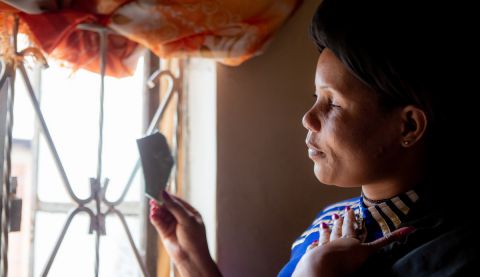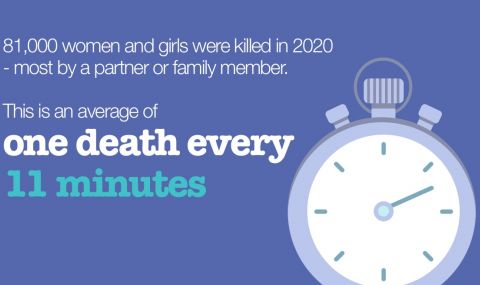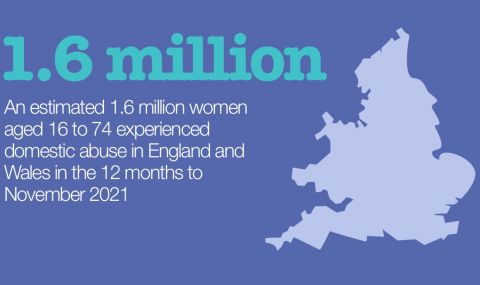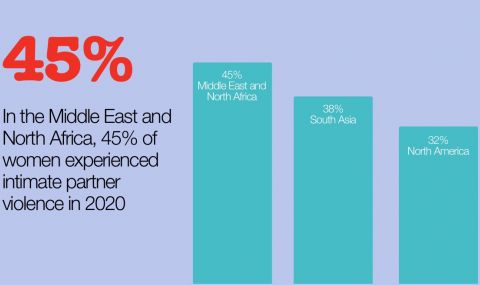Violence against women: the statistics around the world
1 November 2022
Learn about gender-based violence, the statistics and how it affects women and girls from the UK and across the world. You can donate to ActionAid to help give a woman shelter from violence.

Millicent, a survivor of domestic violence from Uganda. Millicent features in ActionAid's charity Christmas appeal 2022. Photo: Karin Schermbrucker/ActionAid
Violence against women and girls is a fundamental human rights violation, affecting around one in three women and girls around the world.1
From the UK, to the Americas, to Africa, women and girls face forms of violence and discrimination in every society, whether it’s domestic abuse, sexual violence, female genital mutilation or psychological violence.
But ActionAid is working to build a safer world, in which no woman or girl lives in fear of violence.
Below, we set out statistics showing the scale of the problem, and how violence affects women around the world.
Violence against women: the statistics
Research shows gender-based violence affects women and girls in every society around the world.
Globally 81,000 women and girls were killed in 2020, around 47,000 of them (58%) died at the hands of an intimate partner or a family member. This is an average of one death every 11 minutes.2

On average, one woman was killed every 11 minutes globally in 2020.
More research shows that in the past few years, the number of gender-related killings has actually increased, in part due to the global pandemic, lockdowns and the economic impact of these. Between 2019 and 2020, the number of gender-related killings increased in Western Europe by 11%; in Southern Europe the increase was 5%. In North America these killings increased by 8%, and by 5% in South America.3
Most of the violence women and girls face is at the hands of intimate partners and family members, and it begins at an early age. Studies show that one in four young women (aged 15-24 years), who have been in a relationship, will have already experienced violence by an intimate partner by the time they reach their mid-twenties.4

Globally, around a quarter of young women will have already experienced partner violence by the time they reach their mid-twenties.
It is critical to remember, though, that violence is under-reported and the true scale of problem is simply not understood. Indeed, research shows almost half of women who have experienced violence have never told anyone at all.5
Less than 40% of women who experience violence seek help of any sort. In the majority of countries with available data on this issue, among women who do seek help, most look to family and friends. Very few look to formal institutions; less than 10% of those seeking help appealed to the police.6
Violence against women and girls in the UK
Across the UK, research suggests harassment and violence against women and girls is widespread, and has worsened due to the Covid-19 pandemic as a result of measures like lockdowns and disruptions to vital support services.

An estimated 1.6 million women aged 16 to 74 experienced domestic abuse in England and Wales in the 12 months to November 2021 .
- It has been estimated that one in three women over the age of 16 in Great Britain were subjected to at least one form of harassment in the year to November 2021. This increases to two in three for women aged 16 to 34.
- Meanwhile, an estimated 1.6 million women aged 16 to 74 experienced domestic abuse in England and Wales in the 12 months to November 2021.
- Around 5.1 million women aged 18 to 74 experienced some form of abuse when they were children.7
- In the 12 months to March 2020, 81 women were killed in a domestic homicide.8
Sources like crime data, and research from support services, suggest that cases of domestic abuse intensified during Covid-19 lockdowns. For example, in the year ending March 2021, the number of calls logged on the National Domestic Abuse Helpline database increased by 22% against the same period the previous year.9
Violence against women in other Global North countries
In other Global North countries, the prevalence of gender-based violence is similarly high.

11% of women in EU member states have experienced some form of sexual violence.
- A recent study found that 22% of women in Western Europe experienced intimate partner violence in 2020, rising to 32% in North America.10
- A study of European Union member states found that 11% of women have experienced sexual violence in the last 12 months. One in two women have been sexually harassed, and 5% have been raped.11
- Meanwhile in the United States, an estimated 10 million people experience domestic violence every year - about 20 people every minute.
- The state of Oklahoma has the highest prevalence of domestic violence: about 49.1% of Oklahoma women experience domestic violence in their lifetimes, including intimate partner physical violence, rape or stalking.12
Statistics from low- and middle-income countries
Studies show that violence disproportionately affects women living in low- and lower-middle-income countries.

In a comparison of regions, the Middle East and North Africa was found to have the highest prevalence of intimate partner violence in 2020.
- An estimated 37% of women living in the poorest countries in the world have experienced physical and/or sexual intimate partner violence in their life; in some countries the prevalence is as high as one in two.13
- Research suggests women in Middle Eastern and North African countries experience a high prevalence of street-based sexual harassment, like sexual comments, stalking and following.14
- Meanwhile South Africa has been recently ranked as the most dangerous country in the world for women. Only 25% of South African women said they felt safe walking alone at night, the lowest of any country.15
What ActionAid is doing to help build a safer world for women
Together with communities and our partners around the world, ActionAid is working to build a safer world in which no woman has to live in fear of violence.
This includes running women's shelters where women and children can get a warm bed – and a fresh start.
At the shelters, women find not just safety, but a supportive community to help them heal. This includes medical care, psychological support and access to legal professionals so, if they choose to, they can take their aggressors to court.
The shelters are staffed and led by local women - experts who know best how to create lasting change in their communities. They are often survivors of violence themselves.
These shelters are a vital lifeline for women, and every day they’re helping more women to escape violence. But we can’t keep their doors open without your support.
Donate to help end violence
Too many women around the world are facing violence and abuse, with nowhere safe to turn. But violence against women and girls is not inevitable, or unavoidable.
And by helping to fund one of ActionAid's life-changing projects, you could make all the difference.
Your donation could help keep the doors of an ActionAid women’s shelter open. A donation of £10 a month, over a year, could cover the cost of a women’s shelter for a day, while £3 a month could buy first aid items like medicine and bandages for women at a shelter.
You could help give a woman shelter from violence – and a new start – with a gift today.
Footnotes
- 1World Health Organisation, Violence against women, intimate partner and sexual violence against women: http://www.who.int/mediacentre/factsheets/fs239/en/
- 2https://www.unodc.org/unodc/frontpage/2021/November/unodc-research_-2020-saw-every-11-minutes-a-woman-or-girl-being-killed-by-someone-in-their-family.html
- 3https://www.unodc.org/unodc/frontpage/2021/November/unodc-research_-2020-saw-every-11-minutes-a-woman-or-girl-being-killed-by-someone-in-their-family.html
- 4https://www.who.int/news/item/09-03-2021-devastatingly-pervasive-1-in-3-women-globally-experience-violence
- 5https://eige.europa.eu/news/gender-equality-index-2017-we-cannot-be-silent-about-violence
- 6https://www.unwomen.org/en/what-we-do/ending-violence-against-women/facts-and-figures
- 7https://blog.ons.gov.uk/2021/11/24/violence-against-women-and-girls-helping-to-understand-the-scale-and-impact-of-the-problem/
- 8https://blog.ons.gov.uk/2021/11/24/violence-against-women-and-girls-helping-to-understand-the-scale-and-impact-of-the-problem/
- 9https://blog.ons.gov.uk/2021/11/24/violence-against-women-and-girls-helping-to-understand-the-scale-and-impact-of-the-problem/
- 10https://www.statista.com/statistics/1212170/share-of-women-who-suffered-intimate-partner-physical-and-or-sexual-violence-by-region/
- 11https://rm.coe.int/1680591fd9
- 12https://worldpopulationreview.com/state-rankings/domestic-violence-by-state
- 13https://www.who.int/news/item/09-03-2021-devastatingly-pervasive-1-in-3-women-globally-experience-violence
- 14https://www.unwomen.org/en/what-we-do/ending-violence-against-women/facts-and-figures
- 15https://worldpopulationreview.com/country-rankings/most-dangerous-countries-for-women



